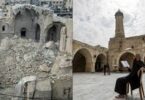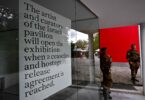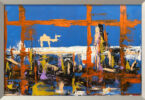Monitoring Desk
LONDON: Beirut has long been recognized as the Middle East’s capital of art and culture. But Lebanon’s financial crisis and political instability, and the devastating explosion at Beirut Port in August 2020, have caused the destruction of much of the city and made life increasingly difficult for its creative community.
While rebuilding continues in the much-loved Lebanese capital, architects and designers persevere to champion and commemorate the richness of its architectural heritage — modern buildings alongside Ottoman edifices; Roman and Byzantine structures in addition to stylistic nods to the Phoenicians, Umayyads, Crusaders, Mamluks, and French.
French-Lebanese architect Annabel Karim Kassar, a London Design Medal winner, has a new installation at the Victoria and Albert Museum in London. “The Lebanese House: Saving a Home, Saving a City” runs until August 21.
The Beirut Port blast severely damaged hundreds of heritage buildings predominantly located in the historic downtown neighborhoods of Mar Mikhaël and Gemmayzeh, many of which were already in a state of disrepair. The Lebanese government has shown little interest in restoring them.
“Just because the situation in Lebanon is a mess doesn’t mean that we have to stop talking about culture, heritage and preservation,” Kasser told Arab News. “Part of my duty and mission as an architect now is to discuss what happened to the buildings of Beirut after the explosion and raise awareness (of the need) for their preservation.”
Kassar’s installation reflects her ongoing mission to restore Bayt K, one of the few remaining classic Ottoman-Venetian homes left in the historic quarters of Gemmayzeh in Old Beirut, and one that she had been working on for several years prior to the blast. In 2017, Kasser unveiled Handle with Care, a project focusing on the conservation of Bayt K, for Beirut Design Week. The project was a public intervention emphasizing the importance of conserving and restoring the port city’s historic Ottoman-Venetian buildings, particularly in the aftermath of the Lebanese Civil War and Beirut’s commercial building boom around 2014. (According to CNN, real estate purchases totaled $8.7 billion in 2014 alone and roughly 400 building projects are currently underway in the Lebanese capital.)
That boom has vanished now amid Lebanon’s political and economic crises. But Kassar’s mission to preserve Bayt K has taken on new life abroad with her V&A installation— a to-scale reconstruction of the façade of the building created by Beiruti craftsmen who came to London from Beirut. The installation was constructed by hand on site at the museum. “Tiles, marble, and other pieces from the original home are all being used in the installation in London,” she said.
The centerpiece of the installation is a triple arcade, exemplifying a trademark of traditional Lebanese architecture that dates back to the 19th century. Kassar has also reinterpreted the traditional liwan — a small salon located in the entrance hall of a typical Lebanese residence — and recreated a typical reception area, replete with long, colorful cushions, inviting the museum’s visitors to pause and contemplate the installation and its significance.
Bayt K’s reconstruction at the V&A is being used as a catalyst to further inspire the restoration and rebuilding of Beirut. The installation includes three accompanying documentary films, commissioned by Kassar, by directors Wissam Charaf and Florence Strauss that explore the emotional impact of the explosion through interviews with people from Beirut.
Since the V&A’s opening in the mid-19th century, the museum has demonstrated an interest in architectural conservation around the world. Through its Culture in Crisis program, it acts as a resource and center for the protection of the world’s cultural heritage. For example, the V&A’s editorial project, “Beirut Mapped,” explores the impact of the blast and its economic and political consequences from the perspective of the artists and writers who live there.
“Saving a Home, Saving a City,” as Kasser stresses, uses the vehicle of the Lebanese home — its preservation, its heritage and its beauty — to remind viewers of Lebanon’s rich past. A home is a place of memories, a structure where families often live for generations, and a place that becomes a crucial component of human and cultural identity.
As Kasser states: “This exhibition is not just about our homes, but about the memories of people and continuity — that is something that is missing a lot in Beirut now.
“I want people to remember their city and its history through these houses,” she continues. “This is not just about architecture; it is about memories that are transported across generations.”
Courtesy: (Arabnews)






